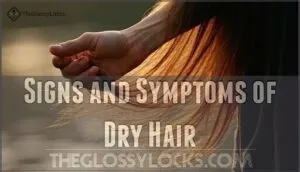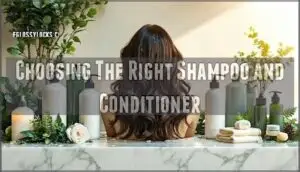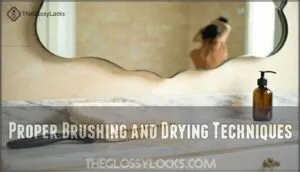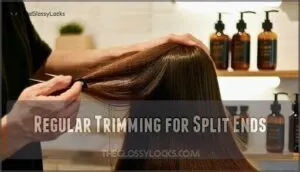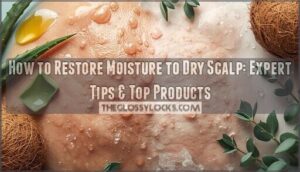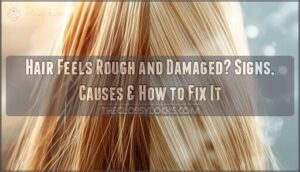This site is supported by our readers. We may earn a commission, at no cost to you, if you purchase through links.
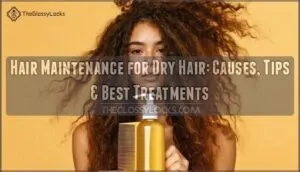 You can spot dry hair from a mile away—it’s the dull, frizzy mane that refuses to behave, no matter how much you coax it. Maybe your morning routine feels like a tug-of-war with your own scalp, or you’ve noticed split ends multiplying faster than you can snip them.
You can spot dry hair from a mile away—it’s the dull, frizzy mane that refuses to behave, no matter how much you coax it. Maybe your morning routine feels like a tug-of-war with your own scalp, or you’ve noticed split ends multiplying faster than you can snip them.
Dry hair doesn’t just look tired; it’s a signal that your hair’s protective layers are under attack from sun, hard water, and even what you eat.
If you’re tired of lifeless strands and want real control, understanding hair maintenance for dry hair is your ticket to stronger, healthier locks.
Table Of Contents
Key Takeaways
- Dry hair is caused by environmental stress, daily habits, and genetics, making it tough to manage without the right care.
- Signs like frizz, dullness, breakage, and scalp issues mean your hair is crying out for moisture and protection.
- Simple routine changes—gentle washing, hydrating products, careful brushing, and regular trims—can revive dry strands and prevent further damage.
- Eating nutrient-rich foods, staying hydrated, and avoiding harsh styling habits are just as important for keeping your hair healthy and strong.
What Causes Dry Hair?
Dry hair doesn’t happen by accident. Your strands lose moisture for specific reasons that range from what’s in your water to what’s in your genes.
Let’s break down the three main culprits behind your parched hair.
Environmental Factors (sun, Humidity, Water Quality)
From relentless sun rays to sneaky minerals hiding in your tap water, the world around you is quietly stealing moisture from every strand. Here’s what you’re up against:
- Sun exposure breaks down your hair’s protective layer and leaves it brittle
- Humidity pulls moisture out while hard water deposits minerals that create dullness and frizz
- Air pollution coats strands with oxidizing particles that damage your hair’s natural defenses
Lifestyle and Habits (smoking, Nutrition, Styling)
Your daily habits hit your hair harder than you might think—and some of them are doing more damage than a week in the desert sun. Smoking starves your follicles of oxygen and weakens every strand. Poor nutrition—especially skipping protein or loading up on sugary drinks—triggers hair damage from the inside out.
Heat styling and harsh haircare routines strip moisture faster than you can replace it. Make lifestyle changes now and your hair health will thank you.
Genetics and Health Conditions
Beyond habits and products, sometimes dry hair is written in your DNA. Genetic testing and family history reveal inherited traits that affect oil production and follicle structure. Health conditions like thyroid disorders disrupt hormonal balance and trigger hair loss. Medical research shows these factors directly impact hair growth, hair nutrition, and overall hair health—leading to chronic hair damage you can’t fix with conditioner alone. Understanding the causes of dry hair, including hair care methods, is essential for effective treatment and prevention.
- Inherited scalp conditions reduce natural oil production
- Thyroid imbalances slow follicle function and moisture retention
- Autoimmune disorders attack hair follicles directly
- Hormonal shifts from PCOS or menopause cause dryness
- Eczema and psoriasis create chronic scalp inflammation
Signs and Symptoms of Dry Hair
Dry hair sends clear signals when it needs help. Your strands might look flat and lifeless or feel rough when you run your fingers through them.
Here’s what to watch for so you can tackle the problem before it gets worse.
Dullness and Lack of Shine
When your hair looks flat and lifeless instead of glossy and full of movement, you’re seeing the telltale signs of a compromised cuticle layer that can no longer reflect light properly. Dry hair struggles with shine restoration because damaged cuticles scatter light rather than bouncing it back smoothly.
| Solution | How It Works | Best For |
|---|---|---|
| Hair serum benefits | Moisture locking and gloss treatment | Daily shine boost |
| Deep conditioning | Hair damage and restoration | Weekly repair |
| Hair nutrition and supplements | Aids hair moisturizing from within | Long-term color enhancement |
| Professional treatments | Intensive hair care and maintenance | Stubborn dryness |
| Cool water rinses | Seals cuticles for light reflection | Quick improvement |
Frizz and Unmanageability
Frizz isn’t just a bad hair day—it’s your strands literally crying out for moisture they can’t find in the air around them. When dry hair lacks proper hydration, the cuticle layer lifts and swells. This creates that wild halo effect no amount of brushing can fix.
Hair smoothening treatments and moisture lock products work because they seal those lifted cuticles. Your best frizz control comes from consistent hair moisturizing and silk treatment serums that deliver real hair taming power.
Breakage and Split Ends
Split ends don’t just happen overnight—they’re the final surrender of a hair strand that’s been fighting dryness for too long. Hair breakage starts at weak points where moisture has fled. These fracture sites multiply until hair fragmentation splits the strand completely.
Watch for these split end repair signals:
- Y-shaped splits at hair tips showing visible separation
- White dots along the shaft marking breakage zones
- Feathered ends that look shredded instead of blunt
- Mid-shaft splits appearing inches above the ends
- Knots forming where damaged strands tangle themselves
Your best fracture prevention is catching hair damage before it travels up the shaft.
Scalp Issues (itchiness, Flaking)
Persistent itchiness and visible flakes signal your scalp’s distress. Up to 42% of adults deal with dandruff-related flaking, while conditions like seborrheic dermatitis affect 16% of the population.
Dry scalp treatment tackles moisture loss directly. Itchy scalp remedies include medicated shampoos with zinc pyrithione for scalp itch relief. Without proper scalp health management, scratching weakens follicles and causes hair damage.
Your hair moisturizer routine should include targeted hair treatment for both strands and scalp, since flaking causes stem from inflammation and barrier dysfunction in dry hair and hair care neglect. Effective dry scalp treatments can provide instant relief for dry, flaky, or itchy scalps.
Essential Hair Care Routine Tips
Your hair care routine is your first line of defense against dryness. Small changes in how you wash, style, and maintain your hair can make a big difference.
Here’s what you need to focus on to keep your strands hydrated and healthy.
Washing Frequency and Water Temperature
You might think washing your hair every day keeps it healthy, but that daily rinse could actually be stripping away the natural oils your strands desperately need. Here’s how to break free from overwashing:
- Wash every 2-3 days to let your scalp’s natural moisturizers work their magic
- Use lukewarm water when shampooing—hot water opens cuticles and invites dryness
- Finish with a cool rinse to seal moisture and boost shine
- Skip shampoo on roots occasionally and focus conditioner on dry ends instead
Choosing The Right Shampoo and Conditioner
The bottles lining drugstore shelves all promise hydration, but most formulas are about as helpful as putting a Band-Aid on a leaky faucet. Look for sulfate-free shampoo with gentle cleansers that won’t strip your hair. Your conditioner should pack moisturizing properties like shea butter or ceramides to restore hair pH balance and lock in hydration.
| What to Look For | Shampoo Ingredients | Conditioner Types |
|---|---|---|
| Gentle Cleansers | Cocamidopropyl betaine, decyl glucoside | Cream-based hydrating formulas |
| Moisturizing Agents | Glycerin, panthenol (provitamin B5) | Leave-in or rinse-out with oils |
| Strengthening Proteins | Hydrolyzed keratin, silk amino acids | Deep conditioning treatments |
| pH Balancers | Citric acid, lactic acid | Acidic conditioners (pH 4-5) |
| Avoid These | Sodium lauryl sulfate, parabens | Silicone-heavy products (long-term) |
Proper Brushing and Drying Techniques
Most people unknowingly snap their hair strands in half every time they reach for a brush or towel. Here’s how to stop the damage:
- Start detangling from the ends and work your way up to prevent hair breakage
- Use a wide-tooth comb for gentle brushing when hair is wet
- Blot with microfiber towels instead of rubbing to preserve hair hydration
- Let hair air dry whenever possible to avoid heat-related hair damage prevention issues
- Apply leave-in conditioner before detangling for easier hair care and maintenance
These simple hair maintenance habits protect dry hair from unnecessary stress.
Regular Trimming for Split Ends
Even if you protect your hair from daily damage, those split ends still need a trim every six to eight weeks to stop damage from climbing up the hair shaft.
Regular maintenance prevents splitting from traveling upward and causing more breakage.
Ask your stylist for dusting—a cutting method that removes just the damaged tips while preserving length for healthier hair growth patterns.
Best Products and Treatments for Dry Hair
Finding the right products can turn dry hair around fast. The key is choosing treatments that actually restore moisture and protect your strands from further damage.
Here’s what works best to bring your hair back to life.
Hydrating Shampoos and Conditioners
Switching to a hydrating shampoo and conditioner is like giving your parched strands their first drink of water after wandering through a desert. Look for gentle formulas with moisturizing ingredients like shea butter or glycerin. Sulfate-free options protect your hair’s pH balance while delivering serious hydration.
Pair your hydrating shampoo with a rich conditioner that locks moisture deep into each strand for healthier results.
Leave-in Conditioners and Serums
Once your shampoo and conditioner have done their part, a leave-in conditioner or serum steps in to guard that moisture all day long. Think of it as your secret weapon for Leave-In Moisture and frizz control. For best results:
- Use Hair Serum Benefits for smoothness
- Try Leavein Conditioner for daily hydration
- Master Serum Application Tips for even coverage
Deep Conditioning Masks and Oils
If you want to take your hair’s hydration up a notch, deep conditioning masks and nourishing oils are like a tall drink of water for thirsty strands. Try Deep Masks packed with shea butter or squalane, and use Hair Oils like coconut or argan. Here’s a quick guide:
| Oil Benefits | Conditioning Tips | Mask Recipes |
|---|---|---|
| Smooths frizz | Apply weekly | Avocado + Honey |
| Adds shine | Use on damp hair | Shea + Yogurt |
| Prevents breakage | Rinse with cool water | Banana + Coconut Oil |
| Repairs ends | Don’t overdo it | Olive Oil + Egg |
| Seals moisture | Focus on lengths | Aloe + Argan Oil |
Salon and At-Home Remedies
Hydration isn’t just a buzzword—it’s your hair’s battle cry. Salon Treatments like keratin or hot oil give instant results, but DIY Remedies like coconut oil masks build moisture over time. Want control? Try this rhythm:
- Salon Treatments every 4–6 weeks
- Leave-In Products post-wash
- Hair Masks or Hair Serums weekly
That’s smart Hair Repair.
Nutrition and Lifestyle for Hair Hydration
What you eat and how you live can make or break your hair’s moisture. If your strands feel dry no matter what products you use, it’s time to look at what’s on your plate and in your daily routine.
Here’s what matters most regarding nutrition and lifestyle for healthy, hydrated hair.
Key Vitamins and Nutrients for Hair Health
Ever wondered why your hair feels like straw after a rough week? Your scalp craves vitamin A, biotin, and a mineral balance for real hydration. Nutrient deficiencies sabotage shine. Here’s a cheat sheet:
| Vitamin Benefits | Hair Nutrients |
|---|---|
| Biotin | Strength |
| Vitamin A | Growth |
| B-12 | Follicle Health |
| Vitamin D | Density |
| Vitamin C | Protection |
Foods to Eat and Avoid
Your plate holds more power over your hair than any bottle in your shower. Load up on nutrient-rich foods like salmon and mackerel for those Omega 3 benefits. Hair-healthy fats—think avocado—keep strands supple.
Skip sugar-free diets loaded with processed junk. Hydrating beverages, soy, and cruciferous veggies boost hair nutrition and hair wellness.
Your hair care starts here.
Impact of Hydration and Overall Wellness
Think of your hair like a thirsty plant—without enough water and care, it’s bound to wilt and lose its shine. Hydration benefits run deep: drinking water, eating hydrating foods, and practicing wellness tips all boost scalp health and hair moisture.
Your hair is like a thirsty plant—nourish it with water, hydrating foods, and wellness to keep it vibrant and healthy
Want real dry hair remedies? Hydrate, rest, and choose moisturizing hair care. That’s true hair health and wellness.
Frequently Asked Questions (FAQs)
How can I protect dry hair while swimming?
Ever wonder why dry hair feels worse after a swim? Pool water protection starts with a snug swim cap. Hair sunscreen shields strands. Rinse for chlorine removal.
After swim care means hydrating masks—your secret weapon for hair damage repair.
What hairstyles help minimize damage to dry hair?
Loose styles like gentle braids or soft twists keep dry hair safe from breakage. Minimal layers and low manipulation techniques help you dodge damage.
These hair care and styling choices support hair moisturizing techniques and boost hair damage repair.
Can scalp massages improve moisture for dry hair?
Scalp massage isn’t magic, but it does boost blood flow to your hair follicle. That means better nutrient delivery, which helps with moisture lock.
Mix massage therapy into your hair care routine for dry hair and see real improvement.
How often should I use clarifying shampoo on dry hair?
Try clarifying shampoo just once a month for dry hair care. Overdoing it strips moisture and leaves hair brittle.
For gentle cleansing, stick to hydrating formulas in your hair care routine between dry hair treatment sessions.
Conclusion
Let’s call a spade a spade—dry hair doesn’t fix itself. Your scalp and strands need real attention, not wishful thinking.
With the right hair maintenance for dry hair, you can change the story from dull and brittle to strong and lively. Every step you take, from the products you choose to the food you eat, shapes your hair’s future.
So, take the reins and give your hair the care it truly deserves.
- https://pmc.ncbi.nlm.nih.gov/articles/PMC11501000/
- https://business.yougov.com/content/52808-us-hair-care-trends-2025-consumer-concerns-routines-and-market
- https://elannashville.com/hair/the-truth-about-hot-tools-and-your-hair/
- https://www.mdhair.co/article/hair-care-trends-in-2023-according-to-dermatologists
- https://xmondohair.com/blogs/thexclusive/summer-hair-care-guide-2025

